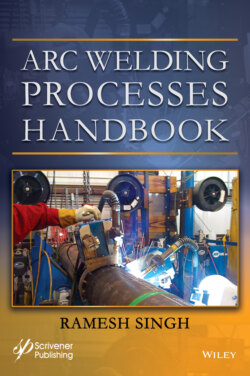Читать книгу Arc Welding Processes Handbook - Ramesh Kumar Singh - Страница 14
Оглавление
Preface
The book Arc Welding Processes Handbook has been developed to address the need of a vast majority of people who want to know about welding, some of them also want to weld as hobbyists, or carry their passion for welding to be a professional welder. The book can also be used as a reference by field engineers and managers responsible for welding and fabrication activities. The book uses several figures and illustration that are available in the public domain, yet wherever it could be identified, the credit has been assigned to the source.
The book will provide readers and practitioners of the profession with an understanding of nearly all aspects of arc welding. The book covers the theory, the principles of the processes, the equipment, and the techniques that would improve the competency in welding, for each welding process. A good number of tables and illustrations are included to accentuate the points as well as to give readers familiarity with things that may or may not be available in their work or school trade workshops.
Chapter 1 introduces the reader to all possible welding process, including arc welding, electric resistance welding etc.
The practice welding procedure (WPS) given especially in Chapter 2 on SMAW process should prove a good basis to start welding and develop into an experienced welder. From here, one can move forward with other processes using the practice welding procedures included in Chapter 3 on GTAW, as well as GMAW processes in Chapter 4. For those who want to start welding, they can start with settings in these procedures and preparations and make changes to develop their skills around them. But it is not necessary to strictly follow this sequence, if someone has already developed the skills in any other process and wants to move to any other process.
The skills required to master FCAW process in Chapter 5 almost mimics the basic skills of GMAW in Chapter 4, and once this process is mastered, moving forward with the FCAW process should not be difficult at all.
The process of SAW in Chapter 6 is very different and very few welding schools will have this process in house. For students to practice on it, in most cases it will have to be learned and mastered on the job. But the chapter on SAW process gives the reader abundant information and familiarity with the process that they can step up to the opportunity when it becomes available.
Included in Chapter 7 is the welding symbols and how to use them, to read those symbols on fabrication drawings and weld accordingly. Reading and understanding the language of welding is an important step in becoming a successful welding professional. The chapter also includes other miscellaneous but important information that would come handy to any welding professional. The most important information is the detailed description of welding symbols and how to use and read them.
This book is best used in a workshop where the reader can pick up the welding torch or holder and try to convert the words from the book to an actual weld.
Ramesh Singh Katy, TX June 2021
